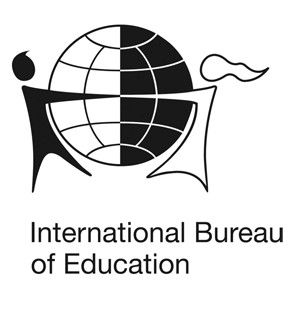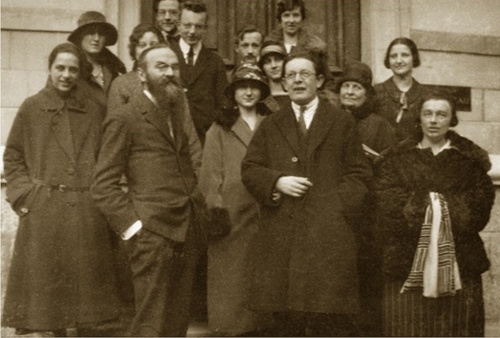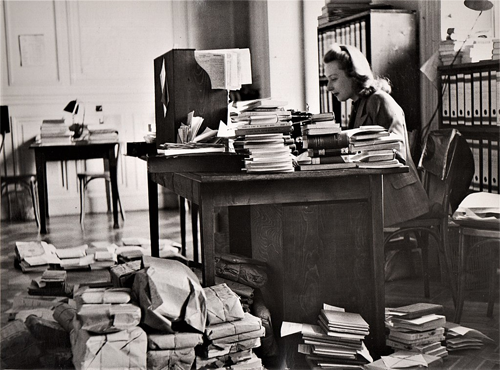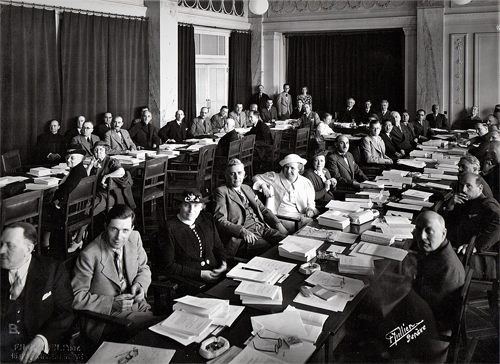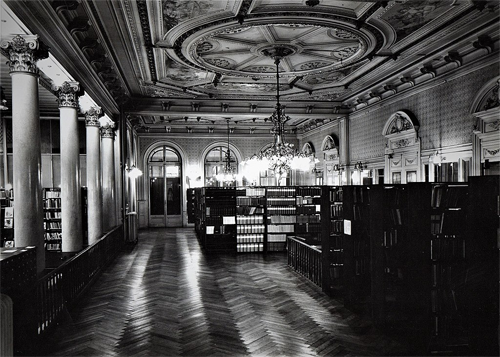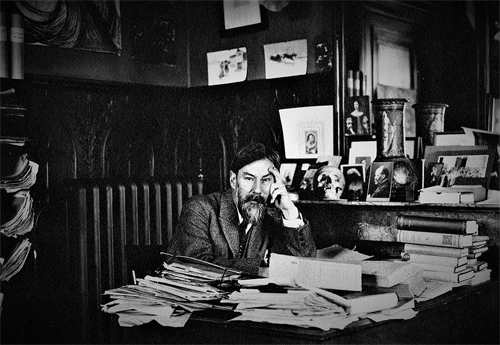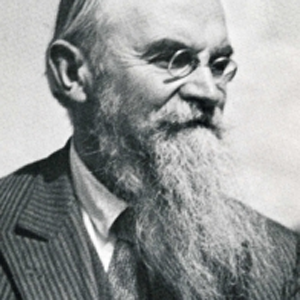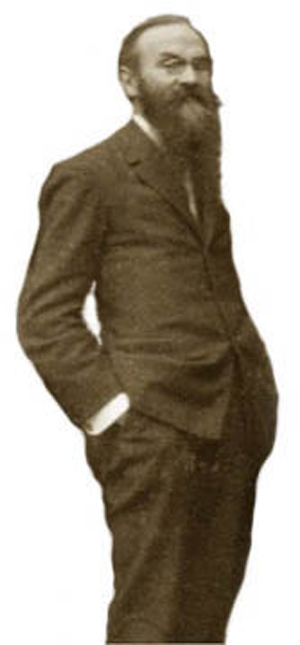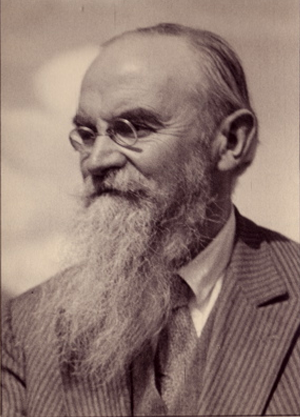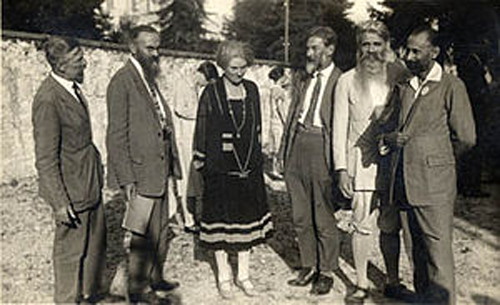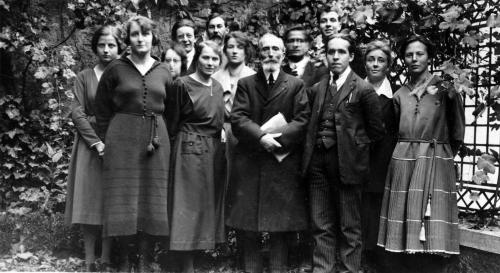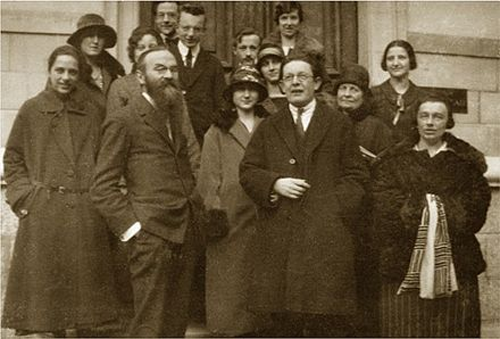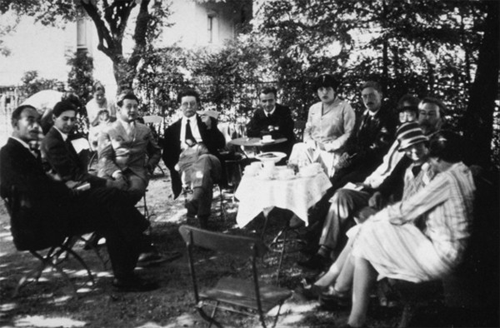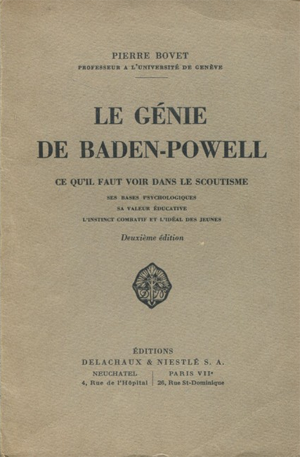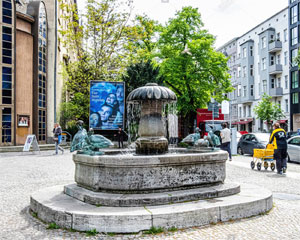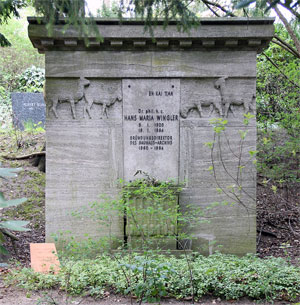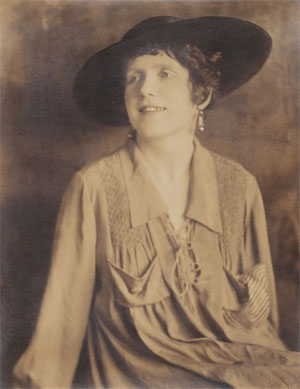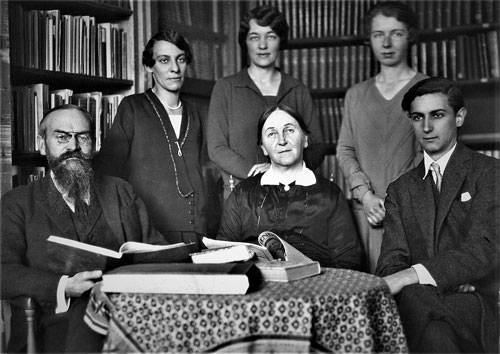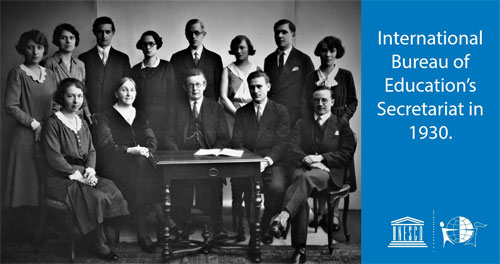Rockefeller Foundationby Wikipedia
Accessed: 8/18/19
NOTICE: THIS WORK MAY BE PROTECTED BY COPYRIGHTYOU ARE REQUIRED TO READ
THE COPYRIGHT NOTICE AT THIS LINK BEFORE YOU READ THE FOLLOWING WORK, THAT IS AVAILABLE SOLELY FOR PRIVATE STUDY, SCHOLARSHIP OR RESEARCH PURSUANT TO 17 U.S.C. SECTION 107 AND 108. IN THE EVENT THAT THE LIBRARY DETERMINES THAT UNLAWFUL COPYING OF THIS WORK HAS OCCURRED, THE LIBRARY HAS THE RIGHT TO BLOCK THE I.P. ADDRESS AT WHICH THE UNLAWFUL COPYING APPEARED TO HAVE OCCURRED. THANK YOU FOR RESPECTING THE RIGHTS OF COPYRIGHT OWNERS.

The Rockefeller Foundation
Founded May 14, 1913; 106 years ago
Founders John D. Rockefeller
John D. Rockefeller Jr.
Frederick Taylor Gates
Type Non-operating private foundation
(IRS exemption status): 501(c)(3)[1]
Location
420 Fifth Avenue, New York City, New York, U.S.
Method Endowment
Key people
Rajiv Shah
(President)
Endowment $4.1 billion (2016)[2]
Website
http://www.rockefellerfoundation.orgThe Rockefeller Foundation is a private foundation based at 420 Fifth Avenue, New York City.[3] It was established by the six-generation Rockefeller family. The Foundation was started by Standard Oil owner John D. Rockefeller ("Senior"), along with his son John D. Rockefeller Jr. ("Junior"), and Senior's principal oil and gas business and philanthropic advisor, Frederick Taylor Gates, in New York State on May 14, 1913, when its charter was formally accepted by the New York State Legislature.[4]
As of 2015, the Foundation was ranked as the 39th largest U.S. foundation by total giving.[5] By year-end 2016 assets were tallied at $4.1 billion (unchanged from 2015), with annual grants of $173 million.[6]
LeadershipOn January 5, 2017, the board of trustees announced the unanimous selection of Dr. Rajiv Shah to serve as the 13th president of the foundation.[7] Shah became the youngest person, at 43,[8] and first Indian-American to serve as president of the foundation.[9] He assumed the position March 1, succeeding Judith Rodin who served as president for nearly twelve years and announced her retirement, at age 71, in June 2016.[10] Rodin in turn had succeeded Gordon Conway in 2005. A former president of the University of Pennsylvania, Rodin was the first woman to head the foundation.[11]
Beginnings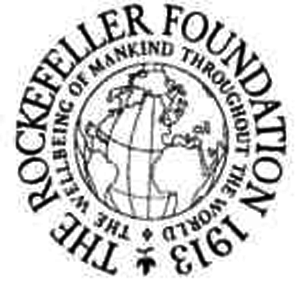 Original Rockefeller logo, no longer in use
Original Rockefeller logo, no longer in useRockefeller's interest in philanthropy and Public Relations began in 1904, influenced by Ida Tarbell's book published about Standard Oil crimes, The History of the Standard Oil Company, which prompted him to whitewash the Rockefeller image.[12][failed verification]
His initial idea to set up a large-scale foundation occurred in 1901, but it was not until 1906 that Senior's famous business and philanthropic advisor, Frederick Taylor Gates, seriously revived the idea, saying that Rockefeller's fortune was rolling up so fast his heirs would "dissipate their inheritances or become intoxicated with power", unless he set up "permanent corporate philanthropies for the good of Mankind".[13]
It was also in 1906 that the Russell Sage Foundation was established, though its program was limited to working women and social ills. Rockefeller's would thus not be the first foundation in America (Benjamin Franklin was the first to introduce the concept), but it brought to it unprecedented international scale and scope. In 1909 he signed over 73,000 shares of Standard Oil of New Jersey, valued at $50 million, to the three inaugural trustees, Junior, Gates and Harold Fowler McCormick, the first installment of a projected $100 million endowment.[13]
They applied for a federal charter for the foundation in the US Senate in 1910, with at one stage Junior even secretly meeting with President William Howard Taft, through the aegis of Senator Nelson Aldrich, to hammer out concessions. However, because of the ongoing (1911) antitrust suit against Standard Oil at the time, along with deep suspicion in some quarters of undue Rockefeller influence on the spending of the endowment, the end result was that Senior and Gates withdrew the bill from Congress in order to seek a state charter.[13]
On May 14, 1913, New York Governor William Sulzer approved a state charter for the foundation – two years after the Carnegie Corporation – with Junior becoming the first president. With its large-scale endowment, a large part of Senior's fortune was insulated from inheritance taxes. The total benefactions of both him and Junior and their philanthropies in the end would far surpass Carnegie's endowments, his biographer Ron Chernow states, ranking Rockefeller as "the greatest philanthropist in American history."[13]
Early grants and connectionsThe first secretary of the foundation was Jerome Davis Greene, the former secretary of Harvard University, who wrote a "memorandum on principles and policies" for an early meeting of the trustees that established a rough framework for the foundation's work. On December 5, the Board made its first grant of $100,000 to the American Red Cross to purchase property for its headquarters in Washington, D.C.[14] At the beginning the foundation was global in its approach and concentrated in its first decade entirely on the sciences, public health and medical education.
It was initially located within the family office at Standard Oil's headquarters at 26 Broadway, later (in 1933) shifting to the GE Building (then RCA), along with the newly named family office, Room 5600, at Rockefeller Center; later it moved to the Time-Life Building in the Center, before shifting to its current Fifth Avenue address.
In 1913 the foundation set up the International Health Commission (later Board), the first appropriation of funds for work outside the US, which launched the foundation into international public health activities. This expanded the work of the Sanitary Commission worldwide, working against various diseases in fifty-two countries on six continents and twenty-nine islands, bringing international recognition of the need for public health and environmental sanitation. Its early field research on hookworm, malaria, and yellow fever provided the basic techniques to control these diseases and established the pattern of modern public health services.[15]
The Commission established and endowed the world's first school of Hygiene and Public Health, at Johns Hopkins University, and later at Harvard, and then spent more than $25 million in developing other public health schools in the US and in 21 foreign countries – helping to establish America as the world leader in medicine and scientific research. In 1913 it also began a 20-year support program of the Bureau of Social Hygiene, whose mission was research and education on birth control, maternal health and sex education.
EuropeIn the interwar years, the Foundation's support of public health, nursing, and social work in Eastern and Central Europe was a concentrated effort to advance medicine and create a global network of medical research.[16] After the war, it sent a team to West Germany to investigate how it could become involved in reconstructing the country. They focused on restoring democracy, especially regarding education and scientific research, with the long-term goal of reintegrating Germany to the Western world.[17]
China Medical BoardIn 1914, the foundation set up the China Medical Board, which established the first public health university in China, the Peking Union Medical College, in 1921; this was subsequently nationalised when the Communists took over the country in 1949. In the same year it began a program of international fellowships to train scholars at the world's leading universities at the post-doctoral level; a fundamental commitment to the education of future leaders.
Department of Industrial RelationsAlso in 1914, the trustees set up a new Department of Industrial Relations, inviting William Lyon Mackenzie King to head it. He became a close and key advisor to Junior through the Ludlow Massacre, turning around his attitude to unions; however the foundation's involvement in IR was criticized for advancing the family's business interests.[18] The foundation henceforth confined itself to funding responsible organizations involved in this and other controversial fields, which were beyond the control of the foundation itself.[19]
PsychiatryDuring the late-1920s, the Rockefeller Foundation created the Medical Sciences Division, which emerged from the former Division of Medical Education. The division was led by Dr. Richard M. Pearce until his death in 1930, to which Alan Gregg to succeeded him until 1945.[20] During this period, the Division of Medical Sciences was known for making large contributions to research across several fields of psychiatry. The 1930s was one of the most prominent decades in Rockefeller Foundation philanthropy to psychiatric research, as the foundation set a goal to find, train, and encourage scholars for research and practice.[21] One of the first large contributions from the Foundation to psychiatric research was in 1935, with the appropriation of $100000 to the Institute for Psychoanalysis in Chicago.[22] This grant was renewed in 1938, with payments extending into the early-1940s.[23]
Social sciencesThrough the Laura Spelman Rockefeller Memorial (LSRM), established by Senior in 1918 and named after his wife, the Rockefeller fortune was for the first time directed to supporting research by social scientists. During its first few years of work, the LSRM awarded funds primarily to social workers, with its funding decisions guided primarily by Junior. In 1922, Beardsley Ruml was hired to direct the LSRM, and he most decisively shifted the focus of Rockefeller philanthropy into the social sciences, stimulating the founding of university research centers, and creating the Social Science Research Council. In January 1929, LSRM funds were folded into the Rockefeller Foundation, in a major reorganization.[24]
Junior became the foundation chairman in 1917. One of the many prominent trustees of the institution since has been C. Douglas Dillon, the United States Secretary of the Treasury under both Presidents John F. Kennedy and Lyndon B. Johnson.
EugenicsBeginning in 1930 the Rockefeller Foundation provided financial support to the Kaiser Wilhelm Institute of Anthropology, Human Heredity, and Eugenics,[25] which later inspired and conducted eugenics experiments in the Third Reich.
The Rockefeller Foundation funded Nazi racial studies even after it was clear that this research was being used to rationalize the demonizing of Jews and other groups. Up until 1939 the Rockefeller Foundation was funding research used to support Nazi racial science studies at the Kaiser Wilhelm Institute of Anthropology, Human Heredity, and Eugenics (KWIA.) Reports submitted to Rockefeller did not hide what these studies were being used to justify, but Rockefeller continued the funding and refrained from criticizing this research so closely derived from Nazi ideology. The Rockefeller Foundation did not alert "the world to the nature of German science and the racist folly" that German anthropology promulgated, and Rockefeller funded, for years after the passage of the 1935 Nuremberg racial laws.[26]
The Rockefeller Foundation, along with the Carnegie Institution, was the primary financier for the Eugenics Record Office, until 1939. [27]
Harvard International SeminarsThe foundation also supported the early initiatives of Henry Kissinger, such as his directorship of Harvard's International Seminars (funded as well by the Central Intelligence Agency) and the early foreign policy magazine Confluence, both established by him while he was still a graduate student.[28]
Programs: scale and scope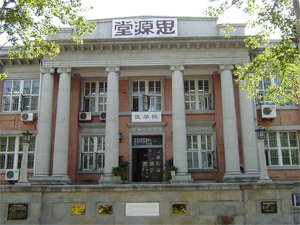 Siyuan Hall,1923 Rockefeller Foundation donated to Nankai University in Tianjin. Now it is Nankai University School of Medicine
Siyuan Hall,1923 Rockefeller Foundation donated to Nankai University in Tianjin. Now it is Nankai University School of MedicineThrough the years the foundation has expanded greatly in scope. Historically, it has given more than $14 billion in current dollars[29] to thousands of grantees worldwide and has assisted directly in the training of nearly 13,000 Rockefeller Fellows.
Its overall philanthropic activity has been divided into five main subject areas:[30]
• Medical, health, and population sciences
• Agricultural and natural sciences
• Arts and humanities
• Social sciences
• International relations
In the 1920s, the Rockefeller Foundation started a program to eradicate hookworm in Mexico. The program exemplified the time period's confidence in science as the solution for everything.[31] This reliance on science was known as scientific neutrality. The Rockefeller Foundation program stated that there was a crucial correlation between the world of science, politics and international health policy. This heavy reliance of scientific neutrality contradicted the hookworm program's fundamental objective to invest in public health in order to develop better social conditions and to establish positive ties between the United States and Mexico.[32] The Hookworm Campaign set the terms of the relationship between Mexico and the Rockefeller Foundation that persisted through subsequent programs including the development of a network of local public health departments. The importance of the hookworm campaign was to get a foot in the door and swiftly convince rural people of the value of public health work. The roles of the RF's hookworm campaign are characteristic of the policy paradoxes that emerge when science is summoned to drive policy. The campaign in Mexico served as a policy cauldron through which new knowledge could be demonstrated applicable to social and political problems on many levels.[33]
A major program beginning in the 1930s was the relocation of German (Jewish) scholars from German universities to America. This was expanded to other European countries after the Anschluss occurred; when war broke out it became a full-scale rescue operation. Another program, the Emergency Rescue Committee was also partly funded with Rockefeller money; this effort resulted in the rescue of some of the most famous artists, writers and composers of Europe. Some of the notable figures relocated or saved (out of a total of 303 scholars) by the Foundation were Thomas Mann, Claude Lévi-Strauss and Leó Szilárd, enriching intellectual life and academic disciplines in the US. This came to light afterwards through a brief, unpublished history of the Foundation's program.[34]
Another significant program was its Medical Sciences Division, which extensively funded women's contraception and the human reproductive system in general. Other funding went into endocrinology departments in American universities, human heredity, mammalian biology, human physiology and anatomy, psychology, and the studies of human sexual behavior by Dr. Alfred Kinsey.[35]
 Trinidad Regional Virus Laboratory Field Assistant, Nariva Swamp, Trinidad. 1959
Trinidad Regional Virus Laboratory Field Assistant, Nariva Swamp, Trinidad. 1959In 1950 the Foundation mounted a major program of virus research, establishing field laboratories in Poona, India; Port of Spain, Trinidad; Belém, Brazil; Johannesburg, South Africa; Cairo, Egypt; Ibadan, Nigeria; and Cali, Colombia. In time, major funding was also contributed by the countries involved, while in Trinidad the British government and neighbouring British-controlled territories also assisted. Sub-professional staff were almost all recruited locally and, wherever possible, local people were given scholarships and other support to be professionally trained. In most cases, locals eventually took over management of the facilities. Support was also given to research on viruses in many other countries. The result of all this research was the identification of a huge number of viruses affecting humans, the development of new techniques for the rapid identification of viruses, and a quantum leap in our understanding of arthropod-borne viruses.[36]
In the arts it has helped establish or support the Stratford Shakespeare Festival in Ontario, Canada, and the American Shakespeare Festival in Stratford, Connecticut; Arena Stage in Washington, D.C.; Karamu House in Cleveland, Ohio; and Lincoln Center for the Performing Arts in New York. In a recent shift[when?] in program emphasis, President Rodin eliminated the division that spent money on the arts, the creativity and culture program. One program that signals the shift was the foundation's support as the underwriter of Spike Lee's documentary on New Orleans, When the Levees Broke. The film has been used as the basis for a curriculum on poverty, developed by the Teachers College at Columbia University for their students.[37]
Thousands of scientists and scholars from all over the world have received foundation fellowships and scholarships for advanced study in major scientific disciplines. In addition, the foundation has provided significant and often substantial research grants to finance conferences and assist with published studies, as well as funding departments and programs, to a vast range of foreign policy and educational organizations, including:
• Council on Foreign Relations (CFR) – Especially the notable 1939-45 War and Peace Studies that advised the US State Department and the US government on World War II strategy and forward planning
• Royal Institute of International Affairs (RIIA) in London
• Carnegie Endowment for International Peace in Washington – Support of the diplomatic training program
• Brookings Institution in Washington – Significant funding of research grants in the fields of economic and social studies
• World Bank in Washington – Helped finance the training of foreign officials through the Economic Development Institute
• Harvard University – Grants to the Center for International Affairs and medical, business and administration Schools
• Yale University – Substantial funding to the Institute of International Studies
• Princeton University – Office of Population Research
• Columbia University – Establishment of the Russia Institute
• University of the Philippines, Los Baños – Funded research for the College of Agriculture and built an international house for foreign students
• McGill University – The Rockefeller Foundation funded the Montreal Neurological Institute, on the request of Dr. Wilder Penfield, a Canadian neurosurgeon, who had met David Rockefeller years before
• Library of Congress – Funded a project for photographic copies of the complete card catalogues for the world's fifty leading libraries
• Bodleian Library at Oxford University – Grant for a building to house five million volumes
• Population Council of New York – Funded fellowships
• Social Science Research Council – Major funding for fellowships and grants-in-aid
• National Bureau of Economic Research[38]
• National Institute of Public Health of Japan (formerly The Institute of Public Health (国立公衆衛生院 Kokuritsu Kōshū Eisei-in) "School of Public Health"ja) in Tokyo (1938)
• Group of Thirty – In 1978 the Foundation invited Geoffrey Bell to set up this high-powered and influential advisory group on global financial issues, whose current chairman is a longtime Rockefeller associate Paul Volcker[39]
• London School of Economics – funded research and general budget
• University of Lyon, France – funded research in natural sciences, social sciences, medicine and the new building of the medical school during the 1920s-1930s
• The Trinidad Regional Virus Laboratory
• The Results for Development Institute – funded the Center for Health Market Innovations
Notable programsThe Rockefeller Foundation has accomplished some notable achievements, such as:
• Financially supported education in the United States "without distinction of race, sex or creed"[40]
• Helped establish the London School of Hygiene and Tropical Medicine in the United Kingdom;
• Established the Johns Hopkins School of Public Health and Harvard School of Public Health, two of the first such institutions in the United States;[41][42]
• Established the School of Hygiene at the University of Toronto in 1927;[43]
• Developed the vaccine to prevent yellow fever;[44][45]
• Helped The New School provide a haven for scholars threatened by the Nazis[46]
The foundation also funded several infamous projects:
• Various German eugenics programs, including the laboratory of Otmar Freiherr von Verschuer, for whom Josef Mengele worked before he went to Auschwitz.
• The construction of the Kaiser Wilhelm Institute's Institute for Brain Research with a $317,000 grant in 1929, with continuing support for the institute's operations under Ernst Rüdin over the next several years.[47]
• An experiment conducted by Vanderbilt University in the 1940's where they gave 800 pregnant women radioactive iron,[48][49] 751 of which were pills,[50] without their consent.[49] In a 1969 article published in the American Journal of Epidemiology, it was estimated that three children had died from the experiment.[50]
The Green RevolutionMain article: Green Revolution
Agriculture was introduced to the Natural Sciences division of the foundation in the major reorganization of 1928. In 1941, the foundation gave a small grant to Mexico for maize research, in collaboration with the then new president, Manuel Ávila Camacho. This was done after the intervention of vice-president Henry Wallace and the involvement of Nelson Rockefeller; the primary intention being to stabilise the Mexican Government and derail any possible communist infiltration, in order to protect the Rockefeller family's investments.[51]
By 1943 this program, under the foundation's Mexican Agriculture Project, had proved such a success with the science of corn propagation and general principles of agronomy that it was exported to other Latin American countries; in 1956 the program was then taken to India; again with the geopolitical imperative of providing an antidote to communism.[51] It wasn't until 1959 that senior foundation officials succeeded in getting the Ford Foundation (and later USAID, and later still, the World Bank) to sign on to the major philanthropic project, known now to the world as the Green Revolution. It was originally conceived in 1943 as CIMMYT, the International Maize and Wheat Improvement Center in Mexico. It also provided significant funding for the International Rice Research Institute in the Philippines. Part of the original program, the funding of the IRRI was later taken over by the Ford Foundation.[51]
Costing around $600 million, over 50 years, the revolution brought new farming technology, increased productivity, expanded crop yields and mass fertilization to many countries throughout the world. Later it funded over $100 million of plant biotechnology research and trained over four hundred scientists from Asia, Africa and Latin America. It also invested in the production of transgenic crops, including rice and maize. In 1999, the then president Gordon Conway addressed the Monsanto Company board of directors, warning of the possible social and environmental dangers of this biotechnology, and requesting them to disavow the use of so-called terminator genes;[52] the company later complied.
In the 1990s, the foundation shifted its agriculture work and emphasis to Africa; in 2006 it joined with the Bill & Melinda Gates Foundation[53] in a $150 million effort to fight hunger in the continent through improved agricultural productivity. In an interview marking the 100 year anniversary of the Rockefeller Foundation, Judith Rodin explained to This Is Africa that Rockefeller has been involved in Africa since their beginning in three main areas – health, agriculture and education, though agriculture has been and continues to be their largest investment in Africa.[54]
Bellagio CenterThe foundation also owns and operates the Rockefeller Foundation Bellagio Center in Bellagio, Italy. The Center comprises several buildings, spread across a 50-acre (200,000 m2) property, on the peninsula between lakes Como and Lecco in Northern Italy. The Center is sometimes colloquially referred to as the Villa Serbelloni. The Villa is only one of the many buildings in which residents and conference participants are housed. The property was bequeathed to the Foundation in 1959 under the presidency of Dean Rusk (who was later to become U.S. President Kennedy's secretary of state). The Bellagio Center operates both a conference center and a residency program.[55] The residency program is a highly competitive program to which scholars, artists, writers, musicians, scientists, policymakers and development professionals from around the world can apply to work on a project of their own choosing for a period of four weeks. The essence of the program is the synergy obtained by the interaction between people coming from the most diverse backgrounds. Numerous Nobel laureates, Pulitzer winners, National Book Award recipients, Prince Mahidol Award winners and MacArthur fellows, as well as several acting and former heads of State and Government, have been in residence at Bellagio.
Rockefeller Foundation Communication for Social Change NetworkThe network is enabled by the Rockefeller Foundation for collaboration between experts and communication professionals that include grassroots/community-based and international non-governmental organizations, as well as multilateral and bilateral entities. Its involvement in AIDS prevention, was based on promoting deep-rooted social changes that stem from informed and inclusive public engagement. However, it recognized that wide-scale educational campaigns focused on altering individual behavior played a critical role.
The strategy and principles linked with the network are listed below:
• "Sustainability of social change is more likely if the individuals and communities most affected own the process and content of communication."[56]
• "Communication for social change should be empowering, horizontal (versus top-down), give a voice to the previously unheard members of the community, and be biased towards local content and ownership."[56]
• "Communities should be the agents of their own change."[56]
• "Emphasis should shift from persuasion and the transmission of information from outside technical experts to dialogue, debate and negotiation on issues that resonate with members of the community."[56]
• "Emphasis on outcomes should go beyond individual behaviour to social norms, policies, culture and the supporting environment."[56]
100 Resilient CitiesIn December 2013, The Rockefeller Foundation launched the 100 Resilient Cities initiative, which is dedicated to promoting urban resilience, defined as "the capacity of individuals, communities, institutions, businesses, and systems within a city to survive, adapt, and grow no matter what kinds of chronic stresses and acute shocks they experience."[57]
Through its program, 100 Resilient Cities offers cities the following resources:[58]
• Financial and logistical guidance for establishing an innovative new position in city government, a Chief Resilience Officer, who will lead the city's resilience efforts
• Expert support for development of a robust resilience strategy
• Access to solutions, service providers, and partners from the private, public and NGO sectors who can help them develop and implement their resilience strategies
• Membership of a global network of member cities who can learn from and help each other
A total of 100 cities across six continents are part of the program, as of May 2016.[59] All 100 cities have developed individual City Resilience Strategies with technical support from a Chief Resilience Officer (CRO). The CRO ideally reports directly to the city's chief executive and helps coordinate all the resilience efforts in a single city.
In January 2016, The United States Department of Housing and Urban Development announced winners of its National Disaster Resilience Competition (NDRC), awarding three 100RC member cities – New York, NY; Norfolk, VA; and New Orleans, LA – with more than $437 million in disaster resilience funding.[60] The grant was the largest ever received by the city of Norfolk.
Cultural Innovation FundThe Cultural Innovation Fund is a pilot grant program that is overseen by Lincoln Center for the Arts. The Rockefeller Foundation selected Lincoln Center to administer the fund based on the institutions steady track record in creating community based partnerships and implementing art based programs.[61][62] The grants are to be used towards innovative ideas that would bring art access and foster cultural opportunities in the underserved areas of Brooklyn and the South Bronx[63] with three overarching goals.
• Increase access to the arts in underserved neighborhoods around New York City
• increase the "places and platforms" where cultural activities are taking place
• support nonprofit organizations in implementing cultural based programs and strategies[62]
Family involvementThe Rockefeller family helped lead the foundation in its early years, but later limited itself to one or two representatives, to maintain the foundation's independence and avoid charges of undue family influence. These representatives have included the former president John D. Rockefeller 3rd, and then his son John D. Rockefeller, IV, who gave up the trusteeship in 1981. In 1989, David Rockefeller's daughter, Peggy Dulany, was appointed to the board for a five-year term.
In October 2006, David Rockefeller, Jr. joined the board of trustees, re-establishing the direct family link and becoming the sixth family member to serve on the board. By contrast, the Ford Foundation has severed all direct links with the Ford family.
Stock in the family's oil companies is a major part of the foundation's assets, beginning with Standard Oil and now with its corporate descendants, including Exxon Mobil.[64][65][66]
Historical legacyThe second-oldest major philanthropic institution in America, after the Carnegie Corporation, the foundation's impact on philanthropy in general has been profound. It has supported United Nations programs throughout its history, such as the recent First Global Forum On Human Development, organized by the United Nations Development Programme (UNDP) in 1999.[67]
The early institutions it set up have served as models for current organizations: the UN's World Health Organization, set up in 1948, is modeled on the International Health Division; the U.S. Government's National Science Foundation (1950) on its approach in support of research, scholarships and institutional development; and the National Institute of Health (1950) imitated its longstanding medical programs.[68]
Current trusteesAs of January 7, 2017[69]
• Richard Parsons (chair), 2007-, chairman of the board, Citigroup Inc.
• Helene D. Gayle, 2009-, president and CEO of CARE.
• Donald Kaberuka, 2015-, former president, African Development Bank Group, Rwanda Minister of Finance and Economic Planning between 1997 and 2005.
• Martin L. Leibowitz, 2012-, managing director, Morgan Stanley; formerly TIAA-CREF (1995 to 2004) and 26 years with Salomon Brothers
• Yifei Li, 2013-, country chair, Man Group China
• Monica Lozano, 2012-, CEO, ImpreMedia, LLC
• Strive Masiyiwa, 2003-, Zimbabwean businessman and cellphone pioneer, founding Econet Wireless.
• Ngozi Okonjo-Iweala, 2009-, Finance Minister of Nigeria; former managing director of the World Bank; former Foreign Minister of Nigeria.
• Judith Rodin, president of the foundation (2005-); ex-officio member of board
• John Rowe M.D., 2007-, professor at the Columbia UniversityMailman School of Public Health; former chairman and CEO of Aetna Inc.
• Rajiv Shah, 2015-, distinguished fellow in residence, Georgetown University; previously administrator of the United States Agency for International Development (USAID) from 2010 to 2015.
• Ravi Venkatesan, 2014-, chairman, Bank of Baroda; previously Microsoft India (2004–2011) and Cummins India
Past trusteesinclude:
• Alan Alda, 1989–1994 – actor and film director. [70]
• Winthrop W. Aldrich 1935–1951 – chairman of the Chase National Bank, 1934–1953; Ambassador to the Court of St. James, 1953–1957.
• John W. Davis 1922–1939 – J. P. Morgan's private attorney; founding president of the Council on Foreign Relations.
• C. Douglas Dillon 1960–1961 – US Treasury Secretary, 1961–1965; member of the Council on Foreign Relations.
• Orvil E. Dryfoos 1960–1963 – publisher of The New York Times, 1961–1963.
• Peggy Dulany, 1989–1994 – Fourth child of David Rockefeller; founder and president of Synergos. [70]
•
John Foster Dulles 1935–1952 (chairman) – US Secretary of State, 1953–1959; senior partner, Sullivan & Cromwell law firm.• Charles William Eliot 1914–1917 – president of Harvard, 1869–1909.
• John Robert Evans 1982 -1996 (chairman) – president of the University of Toronto 1972–1978; founding director of the Population, Health and Nutrition Department of the World Bank
• Ann M. Fudge, 2006-, former chairman and CEO, Young & RubicamBrands, New York
• Frederick Taylor Gates 1913–1923 – John D. Rockefeller Sr.'s principal advisor.
• Stephen Jay Gould 1993–2002 – author; professor and curator, Museum of Comparative Zoology, Harvard University.
• Rajat Gupta, 2006–11, former director, Goldman Sachs, Procter & Gamble, AMR Corporation; Special Advisor to the UN Secretary-General; former managing director, McKinsey & Company.
• Wallace Harrison 1951–1961 – Rockefeller family architect; lead architect for the UN Headquarters complex.
• Thomas J. Healey, 2003–2012, partner, Healey Development LLC; teaching course at Harvard University's John F. Kennedy School of Government; formerly with Goldman Sachs and an Assistant Secretary of the U.S. Treasury.
• Alice S. Huang, senior faculty associate, California Institute of Technology.
• Charles Evans Hughes 1917–1921; 1925–1928 – Chief Justice of the United States, 1930–1941.
• Robert A. Lovett 1949–1961 – US Secretary of Defense, 1951–1953.
• Yo-Yo Ma 1999–2002 – cellist.
• Jessica T. Mathews, president, Carnegie Endowment for International Peace, Washington, D.C.
• John J. McCloy chairman: 1946–1949; 1953–1958 – prominent US presidential advisor; chairman of the Ford Foundation, 1958–1965; chairman of the council on Foreign Relations.
• Bill Moyers 1969–1981 – journalist.
• Diana Natalicio, 2004-, president, The University of Texas at El Paso
• Sandra Day O'Connor, 2006-, associate justice, retired, Supreme Court of the United States
• James F. Orr, III, (board chair), president and chief executive officer, LandingPoint Capital, Boston, Massachusetts.
• Surin Pitsuwan, 2010–2012, secretary general of ASEAN (2007–2012)[71] and Thai politician.
• Mamphela Ramphele, chairperson, Circle Capital Ventures, Cape Town, South Africa.
• David Rockefeller Jr., 2006-, chair of foundation board Dec. 2010- ; vice chairman of Rockefeller Family & Associates; director and former chair, Rockefeller & Co., Inc.; current trustee of the Museum of Modern Art.
• John D. Rockefeller 1913–1923.
• John D. Rockefeller Jr. chairman: 1917–1939.
• John D. Rockefeller III chairman: 1952–1972.
• John D. Rockefeller IV 1976–81.
• Julius Rosenwald 1917–1931 – chairman of Sears Roebuck, 1932–1939.
• Dean Rusk 1950–1961 – US Secretary of State, 1961–1969.
• Raymond W. Smith, chairman, Rothschild, Inc., New York; chairman of Arlington Capital Partners; chairman of Verizon Ventures; and a trustee of the Carnegie Corporation of New York.
• Frank Stanton 1961–1966? – president of CBS, 1946–1971.
• Arthur Hays Sulzberger 1939–1957 – publisher of The New York Times, 1935–1961.
• Paul Volcker 1975–1979 – chairman, board of governors, Federal Reserve Board; president, New York Federal Reserve Bank.
• Thomas J. Watson Jr. 1963–1970?[72] – president of IBM, 1952–1971.
• James Wolfensohn – former president of the World Bank.
• George D. Woods 1961–1967? – president of the World Bank, 1963–1968.
• Võ Tòng Xuân, 2002–2010, vice president for academic affairs, Tan Tao University, Ho Chi Minh City; former rector of An Giang University, the second university in Vietnam's Mekong Delta.
• Owen D. Young 1928–1939 – chairman of GE, 1922–1939, 1942–1945.
Presidents• Rajiv Shah - 2017-, distinguished fellow in residence, Georgetown University; previously administrator of the United States Agency for International Development (USAID) from 2010 to 2015.
• Judith Rodin - 2005–2017; former president of the University of Pennsylvania, and provost, chair of the Department of Psychology, Yale University.
• Gordon Conway – 1998–2004; an agricultural ecologist and former president of the Royal Geographical Society.
• Peter Goldmark, Jr. – 1988–1997; former executive director of the Port Authority of New York and New Jersey.[73]
• Richard Lyman – 1980–1988; president of Stanford University(1970–1980).
• John Knowles – 1972–1979; physician, general director of the Massachusetts General Hospital (1962–1971).[74]
• J. George Harrar – 1961–1972; plant pathologist, "generally regarded as the father of 'the Green Revolution.'"[75]
• Dean Rusk – 1952–1961; United States Secretary of State from 1961 to 1969
• Chester Barnard – 1948–1952; Bell System executive and author of landmark 1938 book, The Functions of the Executive
• Raymond B. Fosdick – 1936–1948; brother of American clergyman Harry Emerson Fosdick
• Max Mason – 1929–1936
• George E. Vincent – 1917–1929; member of the John D. Rockefeller/Frederick T. Gates General Education Board (1914–1929)[76]
• John D. Rockefeller, Jr. – 1913–1917.
See also•
Asia Society• Association Internationale Africaine
• CGIAR
• Eugenics in the United States
• Industrial relations
• Philanthropy
• Philanthropy in the United States
• Rockefeller Brothers Fund
• Rockefeller family
• Social sciences
• Rockefeller Sanitary Commission
References1. FoundationCenter.org, The Rockefeller Foundation, accessed 2010-12-23
2. Rockefeller Foundation. [ Financial Statements December 31, 2016]. Retrieved 2018-01-12.
3. "Company Overview of The Rockefeller Foundation". Businessweek. Retrieved 17 April 2013.
4. "Research Library – The Rockefeller Foundation" (PDF).
5. "Foundation Stats". The Foundation Center. October 2014. Retrieved 2017-08-14.
6. "Financial Statement 2016" (PDF). The Rockefeller Foundation. June 21, 2017. Retrieved 2018-01-12.
7. "A former USAID administrator becomes the thirteenth president of the Rockefeller Foundation – Ventures Africa". Ventures Africa. 2017-01-10. Retrieved 2018-01-03.
8. Gelles, David, “Rockefeller Foundation Picks Rajiv J. Shah, a Trustee, as President”, The New York Times, January 4, 2017. Retrieve 2017-01-04.
9. "The Rockefeller Foundation Names Dr. Rajiv J. Shah, Former USAID Administrator, as Next President – The Rockefeller Foundation". The Rockefeller Foundation. Retrieved 2017-01-06.
10. Ramachandran, Shalini, "Judith Rodin Steps Down as Head of Rockefeller Foundation" (subscription), The Wall Street Journal, June 15, 2016. Retrieved 2017-01-07.
11. "Judith Rodin, Rockefeller Foundation CEO: 'Culture Eats Strategy for Lunch'". Forbes. Retrieved 11 March 2013.
12. "The Rockefellers". American Experience. October 16, 2000. PBS. WGBH. Archived from the original on 2019-03-21. Retrieved 2019-07-01.
13. Chernow, Ron (May 5, 1998). Titan: The Life of John D. Rockefeller, Sr. New York: Random House. pp. 563–566. ISBN 978-0679438083. As early as 1901, Rockefeller had realized he needed to create a foundation on a scale that dwarfed anything he had done so far...
14. Rockfound.org, history, 1913–1919 Archived 2007-05-23 at the Wayback Machine
15. Randall M. Packard, A History of Global Health, Baltimore: Johns Hopkins University Press, 2016 (p. 32–43)
16. Benjamin B. Page, "The Rockefeller Foundation and Central Europe: A Reconsideration." Minerva 40#3 (2002): 265–287.
17. Carola Sachse, "What research, to what end? The Rockefeller Foundat on and the Max Planck Gesellschaft in the early cold war." Central European History 42#1 (2009): 97–141. online
18. Seim, David L. (June 1, 2013). Rockefeller Philanthropy and Modern Social Science. London: Pickering & Chatto. pp. 81–89. ISBN 978-1848933910.
19. Foundation withdrew from direct involvement in Industrial Relations – see Robert Shaplen, Toward the Well-Being of Mankind: Fifty Years of the Rockefeller Foundation, New York: Doubleday & Company, Inc., 1964, (p.128)
20. "The Alan Gregg Papers: Director of Medical Sciences, 1930–1945". profiles.nlm.nih.gov.
21. Rockefeller Foundation, "The Strategy of Our Program in Psychiatry" (The Rockefeller Foundation, November 1, 1937), RG 3.1, series 906, box 2, folder 17, Rockefeller Archive Center, page 1,
https://rockfound.rockarch.org/digital- ... psychiatry22. Theodore Brown, Alan Gregg and the Rockefeller Foundation's Support of Franz Alexander's Psychosomatic Research, Bulletin of the History of Medicine (1987): 155–182
23. Rockefeller Foundation, "Annual Report, 1938," Governance Report, The Rockefeller Foundation: Annual Report (New York, NY, USA: The Rockefeller Foundation, 1939), 171,
https://assets.rockefellerfoundation.or ... t-1938.pdf.
24. Seim, David L. (2013), pp. 103–12
25. Schmuhl, Hans Walter (2008). Kaiser Wilhelm Institute for Anthropology, Human Heredity and Eugenics, 1927–1945. [Dordrecht, Netherlands]: Springer. p. 87.
26. Schafft, Gretchen (2004). From Racism to Genocide: Anthropology in the Third Reich. Urbana: University of Illinois Press. pp. 47–58. ISBN 9780252029301.
27. Jan A. Witkowski, "Charles Benedict Davenport, 1866–1944," in Jan A. Witkowski and John R. Inglis, eds., Davenport's Dream: 21st Century Reflections on Heredity and Eugenics (Cold Spring Harbor Laboratory Press, 2008), p. 52.
28. Early backing of Henry Kissinger – see Walter Isaacson, Kissinger: A Biography, New York: Simon & Schuster, (updated) 2005, (p.72)
29. "The Rockefeller Foundation Timeline". Archived from the originalon 2007-02-12.
30. "The Rockefeller Archive Center – Rockefeller Foundation Archives".
http://www.rockarch.org.
31. Birn, Anne-Emanuelle; Armando Solórzano (1999). "Public health policy paradoxes: science and politics in the Rockefeller Foundation's hookworm campaign in Mexico in the 1920s". Social Science & Medicine. 49 (9): 1197–1213. doi:10.1016/S0277-9536(99)00160-4. PMID 10501641.
32. Birn, Anne-Emanuelle; Armando Solórzano (1999). "Public health policy paradoxes: science and politics in the Rockefeller Foundation's hookworm campaign in Mexico in the 1920s". Social Science & Medicine. 49 (9): 1197–1210. doi:10.1016/S0277-9536(99)00160-4. PMID 10501641.
33. Birn, Anne-Emanuelle; Armando Solórzano (1999). "Public health policy paradoxes: science and politics in the Rockefeller Foundation's hookworm campaign in Mexico in the 1920s". Social Science & Medicine. 49 (9): 1209–1210. doi:10.1016/s0277-9536(99)00160-4. PMID 10501641.
34. Harr, John Ensor; Johnson, Peter J. (August 10, 1988). The Rockefeller Century: Three Generations of America's Greatest Family. New York: Charles Scribner's Sons. pp. 401–03. ISBN 978-0684189369. Major rescue program of European scholars
35. Harr, John Ensor, and Peter J. Johnson, The Rockefeller Century: Three Generations of America's Greatest Family. Medical Sciences Division and Alfred Kinsey funding, p.456.
36. Theiler, Max; Downs, W. G. (1973). The Arthropod-Borne Viruses of Vertebrates: An Account of The Rockefeller Foundation Virus Program, 1951–1970. New Haven and London: Yale University Press. pp. xvii, xx. ISBN 0-300-01508-9.
37. "Charities Try to Keep Up With the Gateses" The New York Times, 2007
38. Funding of programs and fellowships at major universities, foreign policy think tanks and research councils – see Robert Shaplen, op, cit., (passim)
39. AFP Online
40. "Our History – A Powerful Legacy". The Rockefeller Foundation. Archived from the original on 2012-10-30. Retrieved 2011-08-07.
41. Johns Hopkins Bloomberg School of Public Health, History
42. Harvard School of Public Health, History
43. Friedland, Martin L. (2002). The University of Toronto : a history. Toronto [u.a.]: Univ. of Toronto Press. ISBN 0-8020-4429-8.
44. National Library of Medicine
45. "The Wilbur A. Sawyer Papers: From Hookworm to Yellow Fever: Rockefeller Foundation, 1919–1927". profiles.nlm.nih.gov.
46. "History", The New School for Social Research webpage. Retrieved 2013-02-17.
47. Black, Edwin (September 2003). "The Horrifying American Roots of Nazi Eugenics". History News Network. (Also published at San Francisco Chronicle). According to HNN, this material was drawn from Black's books "IBM and the Holocaust" and "War Against the Weak: Eugenics and America's Campaign to Create a Master Race".
48. Pacchioli, David, (March 1996) "Subjected to Science" Archived2013-01-10 at the Wayback Machine, Research/Penn State, Vol. 17, no. 1
49. Miller, Karin (July 28, 1998). "Experiment subjects to get $10.3 million from university". The Santa Cruz Sentinel. Santa Cruz, California. p. 7. Retrieved October 12, 2015 – via Newspapers.com.
50. "1940s study gave radioactive pills to 751 pregnant women". The Galveston Daily News. Galveston, Texas. December 21, 1993. p. 3. Retrieved October 12, 2015 – via Newspapers.com.
51. The story of the Foundation and the Green Revolution – see Mark Dowie, American Foundations: An Investigative History, Cambridge, Massachusetts: MIT Press, 2001, (pp.105–140)
52. "العاب فلاش برق".
http://www.biotech-info.net.
53. "Rockefeller Foundation | Terra Viva Grants Directory". terravivagrants.org. Retrieved 2018-01-03.
54. "A century of innovation? Philanthropy and the African growth story". Retrieved 5 August 2013.
55. The Bellagio Center. The Rockefeller Foundation. Retrieved on 2013-08-24.
56. Scalway, Thomas (2003). "Missing the Message? 20 Years of Learning from HIV/AIDS". Panos Institute: 21.
57. "City Resilience". 100 Resilient Cities. Retrieved 16 March 2017.
58. "About 100RC". 100 Resilient Cities. Retrieved 16 March 2017.
59. "About 100RC". The Guardian. Retrieved 16 March 2017.
60. "About 100RC". Rockefeller Foundation. Retrieved 16 March 2017.
61. "Lincoln Center for the Performing Arts".
http://www.aboutlincolncenter.org. Retrieved 2017-11-09.
62. "Lincoln Center for the Performing Arts in Partnership with The Rockefeller Foundation Announces Inaugural Grantees of Lincoln Center Cultural Innovation Fund – The Rockefeller Foundation". The Rockefeller Foundation. Retrieved 2017-11-09.
63. "Lincoln Center Cultural Innovation Fund Awards Innovation Fund Grants". Philanthropy News Digest (PND). Retrieved 2017-11-09.
64. Share portfolio – see Waldemar Nielsen The Big Foundations, New York: Columbia University Press, 1972. (p.72)
65. Kaiser, David; Wasserman, Lee (December 8, 2016). "The Rockefeller Family Fund vs. Exxon". The New York Review of Books. Retrieved February 27, 2018.
66. Kaiser, David; Wasserman, Lee (December 22, 2016). "The Rockefeller Family Fund Takes on ExxonMobil". The New York Review of Books. Retrieved December 3, 2016.
67. "Global Forum on Human Development". Originally retrieved at Hdr.undp.org on 2013-08-24. Not available at report.hdr.undp.org2017-01-07.
68. "Global Forum on Human Development" (1999). As model for UN organizations, pp.64-5.
69. Board of Trustees, foundation webpage plus associated bio pages on members. Retrieved 2017-01-07.
70. "Rockefeller Foundation Elects 5", "The New York Times" 28, May 1989. Retrieved on 4 January 2019.
71. Parameswaran, Prashanth, "Outgoing ASEAN Chief’s Farewell Tour", The Diplomat, December 19, 2012. Retrieved 2012-12-27.
72. RF Annual Report 1969, p. VI. Retrieved 2011-01-09.
73. Teltsch, Kathleen, "Rockefeller Foundation Selects a New President", The New York Times, May 8, 1988. Goldmark was son of Peter Carl Goldmark. See Blumenthal, Ralph, "Remembering the Travel Scandal at the Port Authority", The New York Times City Room blog, June 24, 2008. Both retrieved 2011-01-09.
74. John Hilton Knowles Papers, The Rockefeller Archive Center. Retrieved 2011-01-09.
75. J. George Harrar Papers, The Rockefeller Archive Center. Retrieved 2011-01-09.
76. George E. Vincent Papers, The Rockefeller Archive Center. Retrieved 2011-01-09.
Bibliography• Berman, Edward H. The Ideology of Philanthropy: The influence of the Carnegie, Ford, and Rockefeller foundations on American foreign policy, New York: State University of New York Press, 1983.
• Brown, E. Richard, Rockefeller Medicine Men: Medicine and Capitalism in America, Berkeley: University of California Press, 1979.
• Chernow, Ron, Titan: The Life of John D. Rockefeller, Sr., London: Warner Books, 1998.
• Dowie, Mark, American Foundations: An Investigative History, Boston: The MIT Press, 2001.
• Farley, John. To Cast Out Disease: A History of the International Health Division of the Rockefeller Foundation (1913–1951) (2005)
• Fisher, Donald, Fundamental Development of the Social Sciences: Rockefeller Philanthropy and the United States Social Science Research Council, Michigan: University of Michigan Press, 1993.
• Fosdick, Raymond B., John D. Rockefeller, Jr., A Portrait, New York: Harper & Brothers, 1956.
• Fosdick, Raymond B., The Story of the Rockefeller Foundation, New York: Transaction Publishers, Reprint, 1989.
• Harr, John Ensor, and Peter J. Johnson. The Rockefeller Century: Three Generations of America's Greatest Family. New York: Charles Scribner's Sons, 1988.
• Harr, John Ensor, and Peter J. Johnson. The Rockefeller Conscience: An American Family in Public and in Private, New York: Charles Scribner's Sons, 1991.
• Jonas, Gerald. The Circuit Riders: Rockefeller Money and the Rise of Modern Science. New York: W.W. Norton and Co., 1989.
• Kay, Lily, The Molecular Vision of Life: Caltech, the Rockefeller Foundation, and the Rise of the New Biology, New York: Oxford University Press, 1993.
• Lawrence, Christopher. Rockefeller Money, the Laboratory and Medicine in Edinburgh 1919–1930: New Science in an Old Country, Rochester Studies in Medical History, University of Rochester Press, 2005.
• Nielsen, Waldemar, The Big Foundations, New York: Cambridge University Press, 1973.
• Nielsen, Waldemar A., The Golden Donors, E. P. Dutton, 1985. Called Foundation "unimaginative ... lacking leadership and 'slouching toward senility.'"
• Palmer, Steven, Launching Global Health: The Caribbean Odyssey of the Rockefeller Foundation, Ann Arbor: University of Michigan Press, 2010.
• Rockefeller, David, Memoirs, New York: Random House, 2002.
• Shaplen, Robert, Toward the Well-Being of Mankind: Fifty Years of the Rockefeller Foundation, New York: Doubleday & Company, Inc., 1964.
• Theiler, Max and Downs, W. G., The Arthropod-Borne Viruses of Vertebrates: An Account of The Rockefeller Foundation Virus Program, 1951–1970. (1973) Yale University Press. New Haven and London. ISBN 0-300-01508-9.
• Rockefeller Foundation 990
Further reading[edit]
• CFR Website – Continuing the Inquiry: The Council on Foreign Relations from 1921 to 1996 The history of the council by Peter Grose, a council member – mentions financial support from the Rockefeller foundation.
• Interview with Norman Dodd An investigation of a hidden agenda within tax-free foundations, including the Rockefeller Foundation (Video).
• Foundation Center: Top 100 US Foundations by total giving
• New York Times: Rockefeller Foundation Elects 5 – Including Alan Alda and Peggy Dulany
• SFGate.com: "Eugenics and the Nazis: the California Connection"
• Press for Conversion! magazine, Issue # 53: "Facing the Corporate Roots of American Fascism," Bryan Sanders, Coalition to Oppose the Arms Trade, March 2004
External links• Rockefeller Foundation website, including a timeline
• Hookworm and malaria research in Malaya, Java, and the Fiji Islands; report of Uncinariasis commission to the Orient, 1915–1917 The Rockefeller foundation, International health board. New York 1920
